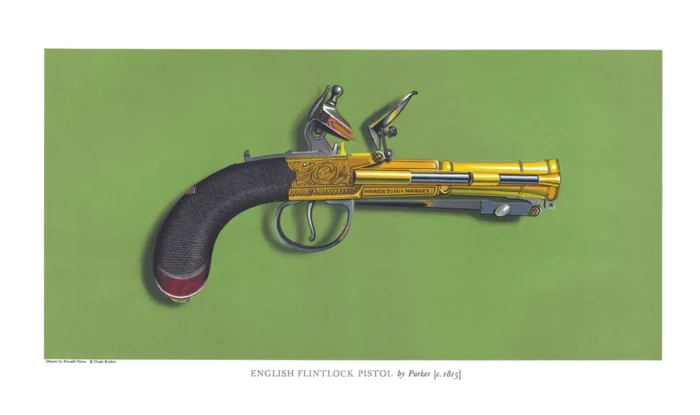English Flintlock Pistol by William Parker c. 1815
Original price was: £17.50.£12.00Current price is: £12.00.
English Flintlock Pistol by William Parker c. 1815 (scroll down for a more detailed Description)
Published 1963 by © Hugh Evelyn Limited; drawn by Ronald Paton
Size: c. 43 x 25.5 cm [17 ″ x 10 ″] may vary slightly from printers’ cut 50 years ago
Printed on white cardstock weighing 112 g/sm2
Print is LARGE size – shipping is the same for 1 to 10 prints (based on largest print size in your order) – see Shipping & Returns
In stock
Description
Probably one of a pair, this pistol is from about 1815 – a boom time for the gunsmiths with the country at war with France. Among the well-to-do, importance was placed on dress and on their equipment. The pistol was admired if the very latest. Pistols of high quality were produced. This pistol belongs to the period of change from sidelock to boxlock. The brass barrel is of blunderbuss form, round for half its length and octagonal from there to the breach. The box containing the lock mechanism is of brass with well executed tooth-like engraving surmounted by leaf scroll. The frizzen, hammer, trigger, trigger guard, safety catch and bayonet are of steel. The butt is walnut, finely chequered, but having a small triangle with a silver octagonal escutcheon. The bayonet pushes placement of the ramrod on the side of the barrel held there by ramrod brass pipes brazed on. On one side of the breech is engraved ‘W. Parker, 233 Holborn, London’. (William Parker was an important gunsmith and supplier of security equipment to Royalty and the police from his principal premises at 233 High Holborn, London). On the opposite side beneath the ramrod ‘Maker to His Majesty’ is engraved. The safety catch is common to box-lock but different to side-lock pistols. When the cock is pulled back to half cock it is automatically in a safety position so the safety catch is an additional precaution. When pushed forward, it engages a notch in the rear of the hammer preventing it from striking the steel. On the forward end of the catch there is a small spike which passes through a hole in the flash guard and engages in a notch in the pan when the pan cover is in the closed position, preventing it from opening. The bayonet is held in the closed position by the trigger guard which has a slot cut in it to take the point of the bayonet and a spring action which enables it to slide backwards and forwards. This well-proportioned bayonet, which swivels on a mounting fixed to the underside of the barrel, is activated by a small but powerful spring incorporated in it and pressing against the barrel. When released, the bayonet swings through an arc of 180 degrees and, by means of a spring catch, secures itself in position on a lug under the barrel muzzle. In a close attack, muzzle-loading pistols once discharged could not be loaded again in time and in an emergency could at best be used as a club. A bayonet extended at the end of a pistol gave one a formidable deterrent to any would-be assailant.
Additional information
| Weight | 0.0122 kg |
|---|---|
| Dimensions | 43 × 25.5 cm |





